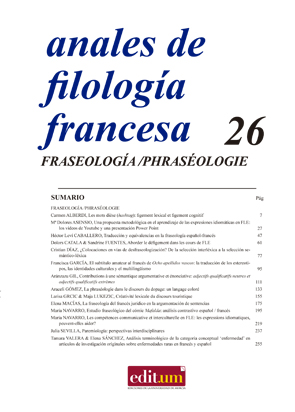On the side of the marginals: the character of Ahmed in The Tower of Defense (1978) of Copy
Abstract
Copi, writer, playwright and draughtsman Argentino settles in Paris in 1962 until his death in 1987. The experience of exile and wandering marks the personal and creative trajectory of this intercultural artist. Indeed, a whole series of vulnerable and marginal characters swarm in their particular universe and subvesivo. In this space of the excluded, the figure of the immigrant Maghreb in France, embodied in the character of Ahmed, acquires all its significance. In this work we will try to analyse the symbolic value of Ahmed, heir to the colonial past marked by rejection, which appears in the Teatro de Copi, specifically in La Défense Tour (1978). Ahmed’s image traces an invisible and symbolic line that separates the two shores of the Mediterranean: the Maghrebi and the French. This dichotomy leaves behind a world of opposite and ambivalent feelings of desire and hatred, love and violence, happiness and misfortunes where the author always Posisionará on the side of the oppressed. Will Ahmed be the symbol of freedom and tolerance, the embodiment of the true solidarity values forgotten by the French society?
Downloads
References
Baubeker, Ahmed. 2012. “Les mondes de l’immigration des héritiers. Ancrages et transmigration” in Multitudesis, Vol. 2, No 49, 100-110.
Bauman, Zygmunt. 2008. Múltiples culturas, una sola humanidad. Madrid, Katz.
Berger, Peter et Luckmann, Thomas. 1989. La construcción social de la réalité. Buenos Aires, Amorrortu.
Cerveras Fras, María José. 1991. “El nombre propio árabe medieval: sus elementos, forma y significado” in Aragón en la Edad Media, No 9, 225-242.
Copi. 1993. Cachafaz. Paris, Christian Bourgois.
Copi. 1999. La Tour de la Défense. Paris, Christian Bourgois.
Copi. 1986. Théâtre. Tome II. Paris, Christian Bourgois.
Douglas, Mary. 2007. Pureza y peligro. Un análisis de los conceptos de contaminación y tabú. Buenos Aires, Nueva Visión.
Goffman, Erving. 1986. Estigma. Buenos Aires, Amorrortu.
Gracia Laure, Ane Lise (2014). Interdits alimentaires et religions: histoire des lois alimentaires édictées par les trois grandes religions monothéistes de notre société: Chistianisme, Islam et Judaïsme ; influence sur les rapports contemporains de l’homme à son alimentation, Thèse Doctorale, Université de Créteil.
Kristeva, Julia. 1980. Pouvoirs de l’horreur. Paris, Seuil.
Ludovic l., Mohamed Zaed. 2012. Le Coran et la chair. Paris, Max Milo.
Mayer, Thierry. 2006. ““Mauvais” prénom, mauvais boulot”. France; TELOS. <https://www.telos-eu.com/fr/societe/social-et-societal/mauvais-prenom-mauvais-boulot.html> [17/11/2017].
Rea, Andrea et Tripier, Maryse. 2008. Sociologie de l’immigration. Paris, La Découverte.
Rey, Alain et Robert Paul, Le Petit Robert des noms propres, Paris, Robert, 1999.
Rosenzvaig, Marcos. 2003. Copi, simulacro de espejos. Málaga, Montes.
Rulleau, Claudine. 2002. “Coran et sexualité. Extraits du textes coranique choisis” in Confluences Méditerranée, No 41, 23-25.
Saadane, Houda et Semmar, Nasredine. 2103. “Transcription des noms arabes en écriture latine” in Revue RIST (CERIST), Vol. 20, No 2, 57-68.
Las obras que se publican en esta revista están sujetas a los siguientes términos:
1. El Servicio de Publicaciones de la Universidad de Murcia (la editorial) conserva los derechos patrimoniales (copyright) de las obras publicadas, y favorece y permite la reutilización de las mismas bajo la licencia de uso indicada en el punto 2.
2. Las obras se publican en la edición electrónica de la revista bajo una licencia Creative Commons Reconocimiento-NoComercial-SinObraDerivada 3.0 España (texto legal). Se pueden copiar, usar, difundir, transmitir y exponer públicamente, siempre que: i) se cite la autoría y la fuente original de su publicación (revista, editorial y URL de la obra); ii) no se usen para fines comerciales; iii) se mencione la existencia y especificaciones de esta licencia de uso.
3. Condiciones de auto-archivo. Se permite y se anima a los autores a difundir electrónicamente las versiones pre-print (versión antes de ser evaluada) y/o post-print (versión evaluada y aceptada para su publicación) de sus obras antes de su publicación, ya que favorece su circulación y difusión más temprana y con ello un posible aumento en su citación y alcance entre la comunidad académica. Color RoMEO: verde.





